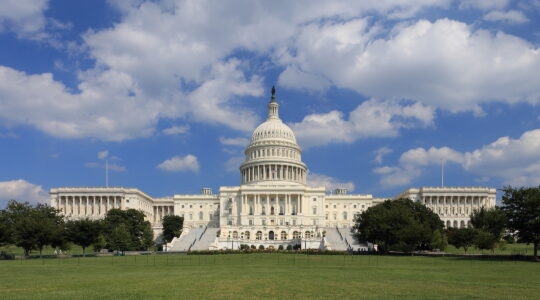LOS ANGELES (JTA) — In the circumcision wars, circumcision has been winning some big battles.
A new survey of medical data going back more than two decades has found that the health benefits of circumcision far outweigh the risks. The publication of the article on April 4 by the medical journal Mayo Clinic Proceedings is the latest development to tip the scales in favor of circumcision in the long-running scientific, cultural and political struggles over the practice.
Some say this series of blows has damaged the efforts of American anti-circumcision activists.
“They’re in disarray. They used to be very organized, raising money and so forth,” said Edgar Schoen, a clinical professor emeritus of pediatrics at the University of California, San Francisco, and a longtime champion of the medical benefits of circumcision. “People don’t listen to them that much anymore.”
The authors of the new survey reviewed some 3,000 studies on male circumcision published since 1988 and found evidence indicating that circumcision significantly reduced the chances of contracting a number of diseases, including urinary tract infections, human papillomavirus and HIV.
“When considered together with ethical and human rights arguments, neonatal circumcision should logically be strongly supported and encouraged as an important evidence-based intervention akin to childhood vaccination,” wrote authors Brian Morris, Stefan Bailis and Thomas Wiswell.
Morris, the study’s lead author and a professor emeritus of medical sciences at the University of Sydney, has long been an advocate for the health benefits of male circumcision, authoring the 1999 book “In Favour of Circumcision.”
Circumcision opponents — known in some circles as “intactivists” — generally dismissed the new study.
“It’s very easy for researchers to design their studies and the analysis of their studies to come out with conclusions that they want,” said Ronald Goldman, author of “Circumcision: The Hidden Trauma.” “So they’re finding what they’re seeking, in other words. There’s no objectivity here.”
The so-called “circumcision wars,” as they have been dubbed by the media, spilled into the American political sphere in 2011 when anti-circumcision activists submitted more than 12,000 signatures to place a San Francisco city ballot measure to ban the practice. The measure spurred heated debate as pro- and anti-circumcision advocates traded accusations of anti-Semitism and child abuse.
However, before the measure could go before voters, a state judge ordered it struck from the ballot as a violation of state law. The California State Legislature subsequently outlawed any local bans on circumcision.
The medical landscape tilted against anti-circumcision activists in 2012 when the American Academy of Pediatrics issued revised guidelines on the practice, stating for the first time that “the health benefits of newborn male circumcision outweigh the risks.” This marked a reversal of the academy’s neutral stance and undercut a key talking point of anti-circumcision activists, who had argued that the practice had no support from any major medical organization.
Anti-circumcision advocates disputed the notion that their efforts have run aground, but some acknowledged that the legal and political terrain has become more challenging.
“There was an enormous and immediate clampdown on any type of legislation gaining a foothold to protect male children in the United States,” said Lloyd Schofield, an anti-circumcision activist who served as a spokesman for the San Francisco ballot measure.
However, Schofield and other anti-circumcision activists point to Europe as more receptive territory.
Attempts to limit or ban non-medical circumcision of boys under 18 have intensified in Europe in recent years. The efforts gained steam after a German court ruled in 2012 that circumcision amounted to causing bodily harm — a ruling that triggered brief bans in various locales in three German-speaking countries.
Last October, the Parliamentary Assembly of the Council of Europe issued a non-binding resolution condemning the practice of circumcision for boys as a “violation of the physical integrity of children.” Several Scandinavian political parties and medical associations are seeking a ban, as are the children’s welfare ombudsmen of Denmark, Finland, Greenland, Iceland, Norway and Sweden.
Jewish groups have pushed back strongly against efforts to ban the practice.
Part of the trans-Atlantic difference in attitudes may be rooted in cultural practices. The study in Mayo Clinic Proceedings cited an estimate that only 10 percent of European males are circumcised. In the United States, the authors calculated that neonatal circumcision rates had dropped from 83.2 percent in the 1960s to 77.1 percent in 2010 as a result of demographic and policy changes.
One of the primary reasons cited by the authors for declining circumcision rates is the country’s rapidly growing proportion of Hispanics, who tend to circumcise their children at far lower rates than non-Hispanic blacks and whites. The report cited figures from the Centers for Disease Control and Prevention indicating that only 44 percent of Mexican-American male infants were circumcised, compared with 76 percent of black males and 91 percent of white males. However, the report also noted that circumcision rates among all three groups appear to be increasing.
Another major factor cited by the report for lower circumcision rates was the reduced number of states that provide Medicaid coverage for circumcision. Currently, 18 states do not cover the procedure through Medicaid, up from just six in 1999. Anti-circumcision groups have urged additional states to cease covering circumcisions.
The new study calculates that hospital circumcision rates are 24 percent higher in states that cover the procedure through Medicaid compared to those that do not, after controlling for other factors.
The American Academy of Pediatrics’ 2012 policy statement explicitly urged insurance providers, including Medicaid, to cover neonatal circumcisions. Though there have been reported efforts in several states to restore Medicaid coverage, to date none have made the switch.
Douglas Diekema, a professor of pediatrics at the University of Washington and a member of the pediatrics academy’s task force on circumcision, urged caution in interpreting the study’s findings, saying that circumcision rates are notoriously difficult to calculate due to the number that are performed outside of hospitals. However, he said the impact on decisions by parents would be driven not so much by the data as by media attention.
“It’s not so much that this paper is so radically important as that it seems to be getting a great deal of press,” Diekema said. “Press coverage gets the attention of parents.”

Help ensure Jewish news remains accessible to all. Your donation to the Jewish Telegraphic Agency powers the trusted journalism that has connected Jewish communities worldwide for more than 100 years. With your help, JTA can continue to deliver vital news and insights. Donate today.






